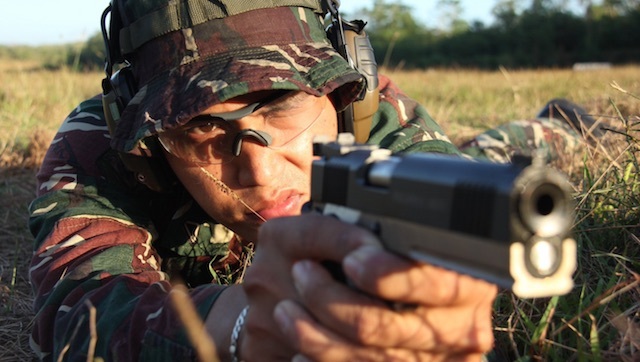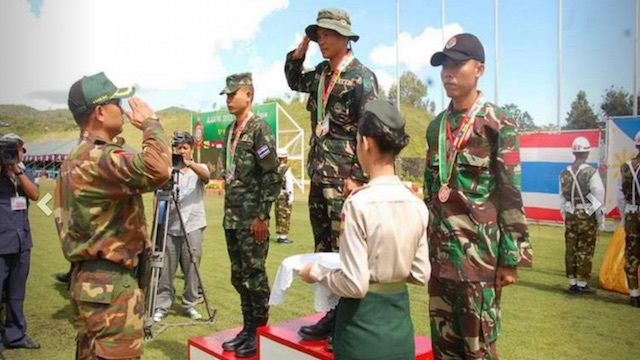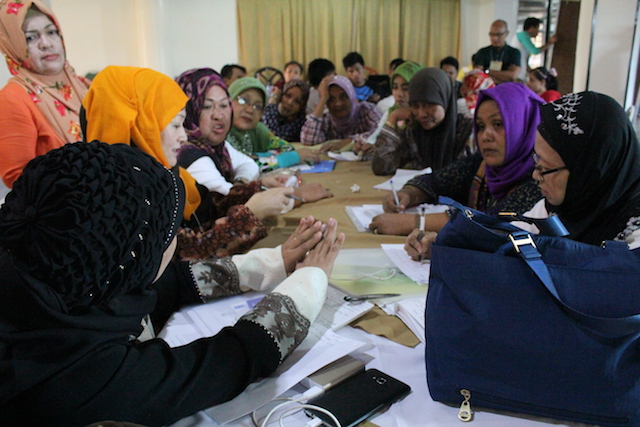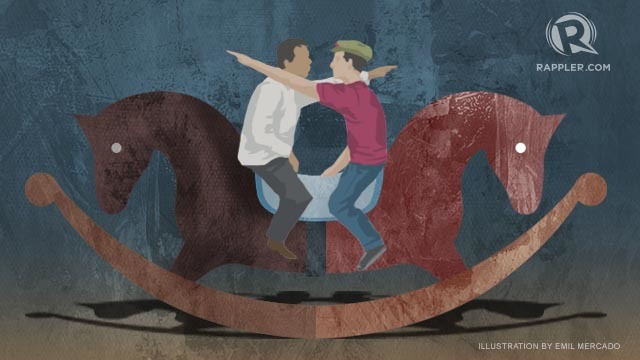From The Standard (Nov 16): US won't turn away from Asia: US admiral
The United States will not end up turning away from Asia in coming years, a top US military official said Tuesday, as Donald Trump's White House win kept regional allies fretting.
The US president-elect sounded fairly isolationist on the campaign trail; in contrast, President Barack Obama, who grew up partly in Indonesia, made the region a priority.
Trump annoyed Japan by saying it was not paying enough in the US-Japanese military relationship.
He even suggested it might become a nuclear power in order to not rely on the United States to defend it.
"It would be inappropriate for me to speculate on a potential policy initiative of the next administration or certainly for me to wade in politics," said Admiral Harry Harris, commander of US Pacific Command.
"That said, I have no doubt that we will continue our steadfast commitment to our allies and partners in the Indo Asia Pacific.
"I want to ease any concerns from our partners and our potential adversaries: the Indo Asia Pacific is as important to America as it ever has been," Harris said.
"I believe that our nation remain the security partner of choice in the region and will remain so well into the future," he added.
US officials, including Obama himself, have rushed to reassure allies on the heels of Trump's November 8 election. Trump is due to take office on January 20.
http://thestandard.com.ph/news/-main-stories/221585/us-won-t-turn-away-from-asia-us-admiral.html
For the last seven decades, US imperialism maintained its neocolonial rule in the Philippines. The US used its political, economic and cultural domination to prolong its rule.
But the US most important facet in preserving its domination is its continued military presence combined with its use of the Armed Forces of the Philippines (AFP) as its pillar of rule.
This role of the AFP as instrument of the US is becoming increasingly evident upon the emergence of an anti-US Duterte regime. These past months, Duterte’s criticisms against US interference and military presence have come one after another. Despite Duterte’s declaration of separation from military and economic ties with the US, one US official averred that they will continue to work with the AFP, and not Duterte. This statement shows the direct US link to the armed machinery of the Philippine government.
History of servitude
Even during the early part of US colonialism, its military already formed and armed Filipino mercenaries to suppress their fellow Filipinos. The former local troops of the Spanish colonialists from Macabebe, Pampanga were reorganized by the US in 1899 and integrated into the newly-formed Philippine Scouts that were pitched into battles against the Filipino revolutionaries. The colonial government also formed the Philippine Constabulary (PC) in 1901 as provincial police to control the population, and later to fight the revolutionaries. As expected, the brutality of US troops against the Filipino people were copied by the Macabebe, Philippine Scouts and PC against their own people. The academy for PC officers established in 1905 in Intramuros was transferred to Baguio City in 1908. By 1936, this academy was opened to officers of the newly-created Philippine Army and came to be known as the Philippine Military Academy (PMA).
From 1935 to 1940, the US established, trained and led the Philippine Army, Philippine Navy and the germinal Philippine Air Force. American general Douglas MacArthur, who was reactivated from retirement, became the commander of Filipino forces. He held this section of the Filipino military, sending them to war against the Japanese. He abandoned them when he deserted at the height of the war in 1941. After the Second World War, the US used its trained Filipino troops to pursue the Hukbong Mapagpalaya ng Bayan. In 1947, the Armed Forces of the Philippines was formally established and some of its battalions were deployed in the US wars of aggression against the people of Korea and Vietnam. JUSMAG direction.
After declaring the Philippines’ bogus independence in 1945, the US maintained tight control of the Philippine armed forces. It imposed a set of unequal military agreements, including the Military Bases Agreement (1946), the Military Assistance Agreement (MAA, 1947) and the Mutual Defense Treaty (1951). Under the MAA, the Joint US Military Advisory Group (JUSMAG) was formed from combined officers and men (starting at 300 personnel under a major general) of the US Army, Navy, and Air Force that would decide the AFP’s counterinsurgency plans, arms and equipment procurement, training, indoctrination and orientation. The JUSMAG offices functioned like a military base, not unlike the 22 other US military bases.
All official expenses of the JUSMAG are being undertaken by the Philippine government, including its offices and housing for its personnel and their families who are now based inside the AFP General Headquarters in Camp Aguinaldo.
JUSMAG advice to the AFP comes directly from the US Pacific Command from courses to be taught PMA cadets, to trainings of Filipino officers under the International Military Education and Training. From 1950 to 1990, more than 20,000 AFP officers were sent to US military camps and trained in US doctrine, military practice and weaponry. JUSMAG also determines the AFP’s arms and equipment procurement, often of the US military’s outmoded stocks. From 2001 to 2015, US military aid to the AFP reached $340M, the fourth largest US military aid.
From 1986-1989 the US sent the AFP almost 2,900 military vehicles, around 50 helicopters, more than 1,650 radios and others. The AFP also received $183.4M military aid from the US under the US-Aquino regime from 2010-2015.
US counterinsurgency operations
The JUSMAG also oversees the implementation of the US government’s Foreign Internal Defense (FID) in the Philippines. FID operations are also known as counterinsurgency operations that are mainly implemented by the US Army Special Forces, with the assistance of Psychological Operations and Civil Affairs forces in their target countries.
These operations include directing AFP operations, training and arming them, and employing large-scale civil-military and intelli gence operations to enhance combat operations. The “triad” (combat-intel-psywar) operations and the “clear-hold” phases of the past AFP counterinsurgency campaigns are clear examples of the US’ FID-based strategies. Barangay zonings in the 1970s against Moro people and the revolutionary movement’s bases are also designed from the US’ hamletting campaign since the 1900s and in Vietnam in 1962.
The US military also occasionally publishes Field Manuals as guide for various fields of counter-insurgency. In the 2010 Field Manual for counterinsurgency, the US Special Forces openly advocated the maximum preponderance of forces as supposedly the most effective way to minimise violence. It also cites large-scale surveillance, censorship, media control, repression of trade unions and political parties, illegal arrests and detention, and other human rights violations, and the associated psychological warfare to make these violations acceptable.
The FID also promotes the training of Civilian Self Defense Forces to further destroy the people’s unity. In the Philippines, the first CAFGU forces were formed by the present Department of National Defense Delfin Lorenzana in 1987 when he was deployed in Davao as commander of the 2nd Scout Ranger Battalion. During that time, he actively supported paramilitary operations such as those by the Alsa Masa.
Likewise, the AFP’s extrajudicial killings of activists and suspected supporters of the revolutionary movement are based on the US FID in El Salvador during the 1970s and 1980s. In the AFP’s case, there have been 238 victims of extrajudicial killings under Oplan Bayanihan by May 2015, and 270 cases of survivors from the shooting. On the other hand, there were more than 1,100 victims of killings under Oplan Bantay Laya 1 and 2 from 2001 till 2009.
Another example of JUSMAG-implemented FID is the operation of around 700 US troops of the Joint Special Operations Task Force-Philippines that have been training battalions of AFP and PNP yearly in the guise of “Balikatan” exercises to use in their “anti-terrorist war.” Aside from troops of the Special Operations Command-Pacific, Central Intelligence Agency agents have been involved in pursuit and combat against the Abu Sayyaf, Jemaah Islamiyah, and those they consider “terrorists” in 2014. The JSOTF-P also trained and directed the PNP Special Action Force that killed alleged terrorist Zulkifli Abdhir (Marwan) in Mamasapano, Maguindanao in January 2015.
US power remains over the government’s armed machinery as long as the JUSMAG and other US-imposed unequal military treaties exist. As long as the AFP does not do away with its puppet orientation, its officers and men will continue to be instruments against the democratic and anti-imperialist interests if the people.
https://www.cpp.ph/afp-pillar-us-rule-philippines/






